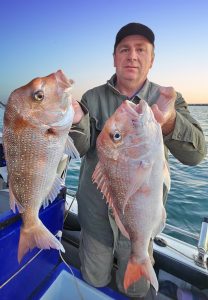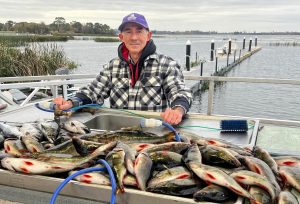
Dragan Medjed with the snapper catch taken offshore from Point Henry (Picture: Dan Gallardo).
Corio Bay/Bellarine Peninsula
Fishing just offshore from Point Henry on Tuesday evening, Dan Gallardo and Dragan Medjed were hopeful of catching a snapper or two, but – although they were getting bites – whatever they were seemed finicky, not at all like snapper.
So, they tried a variety of baits including silver whiting and a snook fillet, but what tempted the two snapper they caught, each around the 3 kg mark, was a pilchard and a strip of squid.
After last week’s report of snapper being caught from the Portarlington breakwaters, I’ve received mail on the downside of what has accompanied the excellent fishing to be found here, and that is the accumulation of rubbish on these structures.
The message is simple: Nothing you bring with you should be discarded inappropriately. If material surplus to your requirements is brought in, it should be taken to a proper disposal site when you leave.
Whiting are still on offer, but an influx of small fish can make prime specimens be hard to find, something Garry Ridgeway and Lindsay Robinson discovered early last week.
However, they stuck it out until nightfall in one of their usually productive spots between Clifton Springs and Curlewis, eventually picking up twenty keepers to 40 cm along with several squid and a decent size flathead.
Fishing for whiting offshore from Point Richards last Tuesday morning, Gordon and Carol Williams were out to catch the last few hours of the incoming tide, but pinkie snapper and small whiting became a nuisance.
However, after making several moves, they found a better class of fish, and using mussel for bait, finished with a respectable tally of keepers to 40 cm before they went off the bite on slack water.

Jimmy Oldani with another good catch, mainly redfin, from Lake Purrumbete (Picture: John Clements).
Freshwater
John Clements of Lake Purrumbete Holiday Park reports that the lake is fishing well with redfin the main species sought.
Some great catches were made by a number of folk over the weekend, including by Jimmy Oldani who used scrubworms for bait.
Simon and Jayden Werner and Michael Dean made the trip from Geelong to Lake Lonsdale near Stawell, and nearby Lake Fyans over the weekend, taking good catches of redfin at both locations. Lake Fyans also produced four pan size trout, three rainbows and one brown.
Kevin Wild of the Maryborough Angling Club reports that club member Ken Hinks also made the journey to Lake Lonsdale where he caught redfin to 40 cm trolling with beetlespins.
Interestingly, when Ken cleaned his fish, he found they’d been dining on yabbies, so there is another species worth trying for.
Kevin also mentions that club member Stephen Eales, along with daughter Lily 7, and son Mason 5, caught 30 redfin to 38 cm fishing the Loddon River downstream from Cairn Curran Reservoir.
Kevin also reports that Tullaroop Reservoir is still closed to boating, but now, with minimal flow over the spillway, he believes that this water will soon be opened to boating again.
Mordialloc
George Vlahogiannis fished Mordialloc Pier on Monday morning, through rain, hail and winds up to 40 knots on occasion, for just 2 pinkies and a 52 cm snapper. However, his companion caught one of 3 kg.
It was much too rough on Tuesday morning though, and when the tide started coming in, it brought in sufficient weed to make it unfishable.
Colin asks:
Is there anything being done at Lake Bullen Merri to solve the blue-green algae problem? It’s really bad.
Colin, an artificial aeration system was introduced at Lake Bullen Merri by VFA in the early 1980s to assist in the destratification of water layers within the lake, a move largely supported by anglers because of the improved water quality – including an amelioration of the algae problem – particularly in the vicinity of this device.
That device was decommissioned after a review conducted in 2009 by VFA on the basis of cost, which was some $15,000 a year, a seemingly small price to pay to help sustain a world class salmonid fishery, but there you are.
More recently, a 12-month trial of four solar-powered. algae-deactivating devices conducted by the Corangamite Shire – which have now been removed – produced encouraging results.
Given the success of this trial, the council hoped Victoria’s Department of Environment, Land, Water and Planning (DELWP) would provide sufficient investment for the installation of, and monitoring of 16 such floating, solar powered devices on the lake.
I have no information that the required investment is forthcoming, which probably means the blue-green algae problem may be here to stay.
Please send your reports to geoffw10@optusnet.com.au, on messenger, or by phone, 03 5248 1307.
